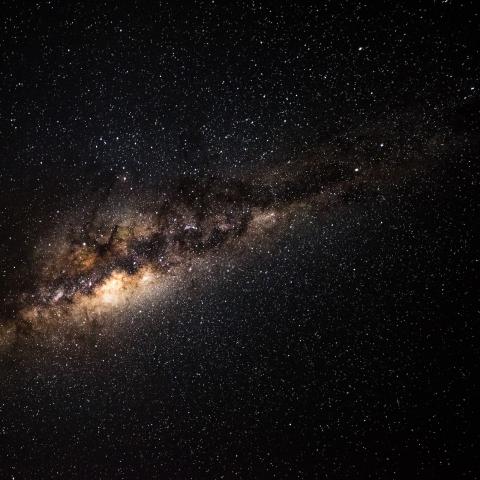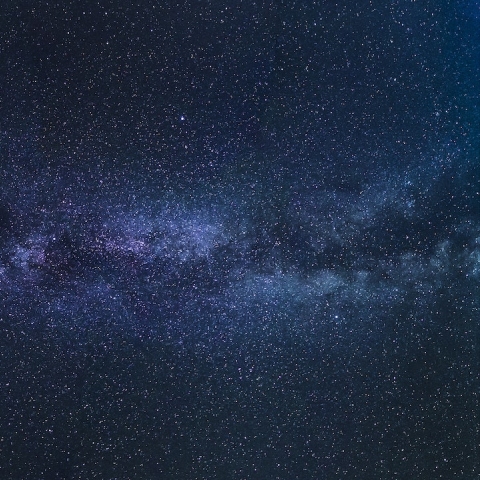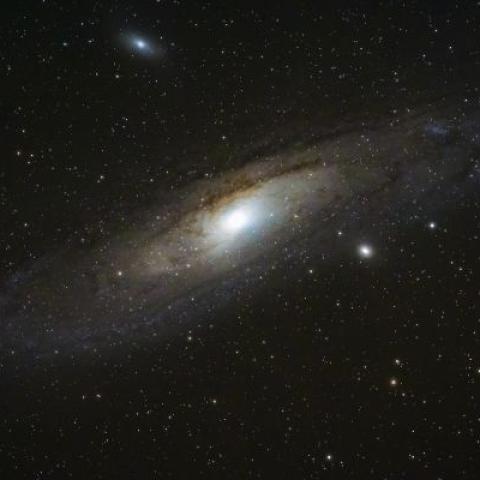
Observational cosmology is the study of the origin, evolution, and current structure of the Universe, enabled by the data gathered from the most powerful modern telescopes and instruments. We use measurements of the large-scale distribution of galaxies, distortions in images of galaxies caused by gravitational lensing, and observations of supernova explosions to answer fundamental questions.
Large scale structure
Galaxies are not distributed uniformly in space, but cluster together tracing the large-scale structure of the Universe. This large-scale structure is itself shaped by the nature of the primordial perturbations, and the interplay of gravitational collapse and cosmic expansion through the history of the Universe.
We use large surveys operated from both ground-based and space-based observatories to map the positions of millions of galaxies. By analysing the clustering patterns in these datasets we uncover information about how the Universe has grown over billions of years, which we use to investigate questions such as the nature of dark energy.
Galaxy survey projects we're involved in
Gravitational lensing
Light doesn’t simply travel through the Universe in straight lines: its path can be bent by the gravitational effects of clumps of matter along its path. This deflection of light is called gravitational lensing and it can lead to both striking images of individual rare distant galaxies that have been stretched and magnified (known as “strong lensing”) and to much more subtle effects on the alignments of groups of galaxies (“weak lensing”) which can only be studied through statistical techniques applied to very large datasets.
At the ICG we study both strong and weak gravitational lensing. Our research reveals information on the contents of the Universe and the distribution of the dark matter which primarily causes lensing, on the nature of the source and lens galaxies, and even on the behaviour of gravity itself.
Gravitational lensing projects we are involved in
Transients
Astrophysical transients are phenomena that appear suddenly in the night sky, brighten for days to months and then fade away and disappear again. This includes novae (eruptions on the surfaces of white dwarfs), supernovae (the explosions of stars), tidal disruption events (stars ripped apart by black holes), and the still mysterious gamma-ray bursts and fast radio bursts. At the ICG, we specialise in the study of supernovae and tidal disruption events.
Supernovae
At the ICG, we focus on three areas of supernova studies:
- Progenitors: understanding which stars explode as different types of supernovae and thus advancing our understanding of the life cycles of stars;
- Explosion physics: working out the details of how these explosions occur and the physics behind them; and
- Cosmology: some types of supernovae (famously, Type Ia supernovae that were used to first discover the accelerated expansion of the Universe) can be used to measure distances to their host galaxies and thus probe cosmology
Tidal disruption events
At the ICG, we work on discovering tidal disruption events (TDEs) in spectroscopic galaxy surveys (DESI, 4MOST) and studying the properties of the host galaxies of these events. This is an exciting new field of study, with plenty of open questions to pick from.
Transients projects we're involved in
- Dark Energy Survey (DES)
- Dark Energy Spectroscopic Instrument (DESI)
- 4-metre Multi-Object Spectroscopic Telescope (4MOST)
- Vera C. Rubin Observatory Legacy Survey of Space and Time (LSST)
- Hubble Space Telescope surveys (BUFFALO, SIRAH)
Recent highlights
Research outputs
-
Testing low-redshift cosmic acceleration with large-scale structure
Nadathur, S., Percival, W. J., Beutler, F. & Winther, H., 5 Jun 2020, In: Physical Review Letters. 124, 22, 6 p., 221301.
-
Constraints on the cosmic expansion rate at redshift 2.3 from the Lyman-α forest
Cuceu, A., Font-Ribera, A., Nadathur, S., Joachimi, B. & Martini, P., 12 May 2023, In: Physical Review Letters. 130, 19, 7 p., 191003.
-
Analysis of unified galaxy power spectrum multipole measurements
Donald-McCann, J., Gsponer, R., Zhao, R., Koyama, K. & Beutler, F., 1 Dec 2023, In: Monthly Notices of the Royal Astronomical Society. 526, 3, p. 3461–3481
-
The Completed SDSS-IV extended Baryon Oscillation Spectroscopic Survey: a multi-tracer analysis in Fourier space for measuring the cosmic structure growth and expansion rate
Zhao, G-B., Wang, Y., Taruya, A., Zhang, W., Gil-Marin, H., Mattia, A. D., Ross, A. J., Raichoor, A., Zhao, C., Percival, W. J., Alam, S., Bautista, J. E., Burtin, E., Chuang, C-H., Hou, J., Dawson, K. S., Kneib, J-P., Koyama, K., Bourboux, H. D. M. D., Mueller, E-M., & 6 others, 1 Jun 2021, In: Monthly Notices of the Royal Astronomical Society. 504, 1, p. 33-52
-
Overview of the Instrumentation for the Dark Energy Spectroscopic Instrument
DESI Collaboration, Canning, R., Donald-McCann, J., Graur, O. & Nadathur, S., 20 Oct 2022, In: The Astronomical Journal. 164, 5, 62 p., 207.
Research Staff in Observational Cosmology
Discover our areas of expertise
Observational cosmology is one of the 4 areas of expertise within the Cosmology and Astrophysics research area – explore the others here.
Gravitational waves
We're detecting cosmic gravitational waves and developing gravitational-wave observations as an astronomical tool.

Theoretical cosmology
We're exploring the inflation of the very early Universe, the impact of dark energy on its geometry and developing tests to monitor its expansion.

Astrophysics
We're working to better understand the basic building blocks of our Universe, the origin of stars, the formation and evolution of galaxies, and stellar population models. Explore our astrophysics research

Research groups
Institute of Cosmology and Gravitation
We're researching galaxies and stars, large-scale structures, gravitational waves and dark energy.
Applied Physics Research Group
We're exploring research in quantum information technologies, quantum optics and quantum foundations and applied advanced materials.
Interested in a PhD in Cosmology and Astrophysics?
Browse our postgraduate research degrees – including PhDs and MPhils – at our Cosmology and Astrophysics postgraduate research degrees page.













